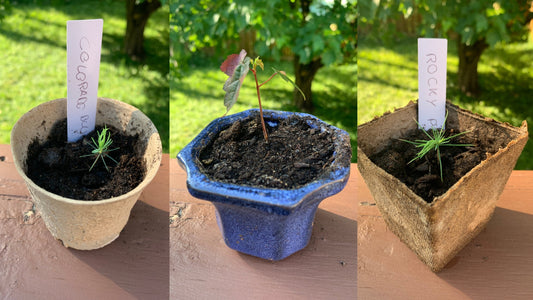1. Introduction: what is a Haiku?
Haiku, a centuries-old Japanese poetic form, is a subtle art that captures the essence of a moment in just 17 syllables. These short poetic compositions, often about nature, have a depth and simplicity that make them captivating. In this article, we invite you to dive into the world of Haiku, to discover its history, structure and themes, and to learn to write your own poems following its fundamental rules and principles. At Ikigai Box , we are passionate about all Japanese arts, Haiku is an important one.
Origins of Haiku
Haiku has its origins in haikai, a form of popular Japanese poetry from the 17th century. Originally, these poems were stanzas of renga (or renku), a collaborative poetic form that consisted of several stanzas written by different poets. A stanza is a set of verses that can include a particular arrangement of rhymes, forming with others a poem, with white lines individualizing them. The haikai was the first stanza of this poem, often humorous or satirical, which served as an introduction to the series of stanzas to come.
In the 19th century, haikai evolved to become Haiku, an independent and autonomous poetic form. Haiku masters, such as Matsuo Bashō ,Yosa Buson , and Kobayashi Issa , perfected this form, giving it its distinctive rules and characteristics.
Structure of the Haiku
The Haiku is composed of three lines, with a fixed syllabic structure: 5 syllables in the first line, 7 in the second, and 5 again in the third . This 5-7-5 structure is a formal constraint which forces the poet to be concise and to choose his words carefully to express his thoughts in a precise and evocative way.
Traditional Haikus are often written in a single vertical line, which makes them visually distinct from other poetic forms. This presentation is an important feature of Haiku, as it contributes to its simplicity and visual impact.
Haiku Themes and Subjects
Traditional Haikus often deal with nature and the seasons, reflecting the deep connection the Japanese have with their natural environment. Seasons are particularly important in Haiku, and each season has its own keywords (kigo) that evoke specific images associated with that time of year.
Besides nature, Haikus can also address more universal themes such as love, death, loneliness and spirituality. Whatever the subject, the goal of Haiku is to capture the present moment and reveal a profound truth about the nature of reality.

2. Techniques and Style of Haiku
Haiku, despite its brevity, is based on specific techniques and style which give it its depth and evocative power. Here are some key elements of the haiku style:
Simplicity
Simplicity is a fundamental characteristic of Haiku. Each word is carefully chosen for its precise meaning and its ability to evoke clear and powerful images. The goal is to express a lot with a little, capturing the essence of a moment in just a few words.
Vivid Imaging
Haikus are often filled with vivid imagery that evokes the reader's senses. They use words that describe colors, sounds, smells and physical sensations to create a complete sensory experience in just a few words. We create a Haiku every month and highlight it on our social networks with a Real. Often, we shot the video which is in the background in an exceptional place where we spent our vacation.
Seasons and Nature
Nature and the seasons occupy a preponderant place in Haiku. Poets use kigo (seasonal keywords) to set their poem in a specific season and evoke the sensations and emotions associated with that time of year.
Sense of the Ephemeral
Haiku often captures fleeting moments of beauty or truth. It highlights the transient nature of life and the importance of savoring each moment, because everything is destined to disappear.
Cutoff and Contrast
A common technique in Haiku is the cut, which consists of a sudden pause or change in the poem that creates contrast or tension. This technique adds depth to the poem by suggesting multiple meanings or emphasizing a particular aspect of the subject.
By exploring these techniques and integrating them into your own writing, you will be able to capture the essence of Haiku and create evocative and meaningful poems.
3. Famous Haikus
Haiku has a long history and many renowned poets have contributed to its development and popularity. Here are some examples of famous Haikus that illustrate the beauty and depth of this poetic form:
Matsuo Bashō (1644-1694)
"An old pond
A frog jumps
The sound of water"
This Bashō Haiku is one of the most famous of all time. It captures a moment of calm and simplicity, highlighting the beauty of nature and the poetry of the present moment.
Yosa Buson (1716-1784)
"On the broken branch
The crow sits
Evening falls"
This Buson Haiku is a classic example of using imagery to evoke emotions and sensations. The scene is simple but evocative, creating an atmosphere of calm and solitude.

Kobayashi Issa (1763-1828)
"In the world of haikus,
We're just passing through
Like bees on a flower"Issa was known for his haikus imbued with compassion and empathy for the human condition. This Haiku reflects the fleeting nature of life and the need to savor each moment.
Masaoka Shiki (1867-1902)
"The cherry blossoms,
I watch it pass
People"
This Haiku by Shiki captures the essence of spring and the transience of beauty. It highlights the relationship between man and nature, emphasizing the simplicity and depth of the human experience.
These famous Haikus illustrate the diversity and richness of this unique poetic form. By studying them, we can better understand the art of Haiku and appreciate its timeless beauty.
4. Creating Your Own Haiku
Writing a Haiku may seem simple, but it is a delicate art that requires practice and reflection. Here are some tips for creating your own Haiku:
Choose a topic
Haiku traditionally focuses on nature and the seasons, but you can choose any subject that inspires you. Try to find something simple but evocative, like a flower opening in the sun or a leaf gently falling.
Capture the Moment
Haiku seeks to capture a fleeting moment, often using simple but powerful images. Try to describe a scene or feeling in a few words, using concrete and evocative details.
Use the 17 Syllable Structure
The traditional Haiku is composed of three lines, with a syllabic structure of 5-7-5. This means that the first line has 5 syllables, the second line has 7, and the third line has 5 again. Follow this structure to create an authentic Haiku.
Be Concise and Evocative
Haiku should be brief but meaningful, capturing the essence of a scene or emotion in a few words. Avoid excessive descriptions or unnecessary words, and opt for simple but powerful images.
Review and Refine
Once you have written your Haiku, take the time to reread and refine it. Look for ways to improve the clarity, flow and impact of your words, eliminating anything that seems superfluous or redundant.
By following these tips, you will be able to create your own unique and evocative Haiku. Feel free to experiment with different topics, images, and words to find your poetic voice.
5. Share Your Passion for Haiku

You create Haikus, we would love to read them, share them with us on our social networks or at info@ikigai-box.com!
Besides, we create 1 per month and share it in Real form on our social networks, don't hesitate to tell us what you think!
- Instagram: @ikigaibox1
- Facebook: @ikigaibox1
- TikTok: @ikigai.box
6. Conclusion
Haiku is much more than just a form of poetry: it is an art that captures the essence of life and nature in a few simple but evocative words. By discovering the art of Haiku, you enter a world of beauty and contemplation, where every word counts and every image resonates. Whether you are a poetry lover or simply curious to explore new forms of expression, Haiku offers a unique and enriching poetic experience. So, let yourself be carried away by the magic of the 17 syllables and discover the full depth of traditional Japanese poetry.




